Robot vacuum cleaners (also known as Roombas) are a fantastic way to get your house cleaned without the need to wade through piles of kitty litter or dust bunnies, but there are a few tricks to using them effectively.
If you’ve even briefly used one of these popular machines, you know that they can get stuck on carpets or other floorings or on the obstacles in their way. So, how to stop a robot vacuum from getting stuck?
First of all, find the reason why your Roomba keeps getting stuck?
Reasons Why Robot Vacuums Get Stuck
1. Obstacles and Clutters on the Floor
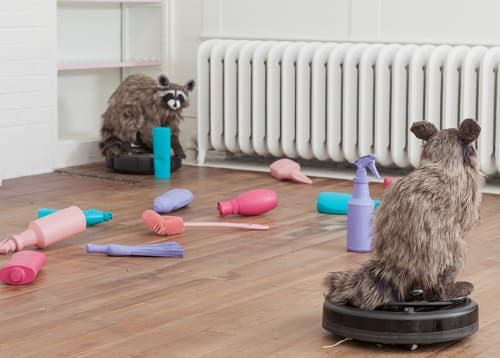
This is the most common reason for a robot vacuum to get stuck. Obstacles and clutters on the floor like scattered toys, clothes, other household items, etc., are very common if you have kids at home.
Kids’ toys on the floor make a zigzag maze for your robot vacuum, so it will cease to work in such an environment. Similarly, the clothes lying on the floor may get stuck in the wheel of the robot vacuum, causing it to stop. Additionally, other clutter scattered on your floor may prevent your robot vacuum from working.
Check For The Things You Should Never Vacuum
2. Computer Cables and Other Wires Lying on The Floor
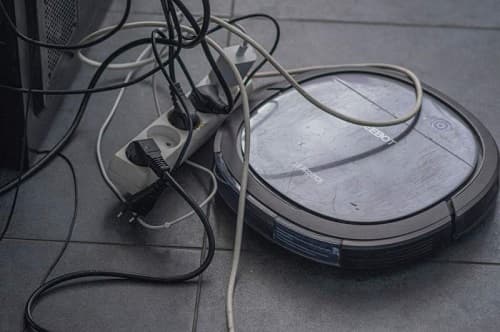
Leaving computer cables and other wires on the floor may also cause the robot vacuum to get stuck. Maybe it’s the power cord, the charging cord, or the wall cord for your desktop that impedes your robot vacuum’s operation. These wires can easily get stuck on the wheels of the robot vacuum, preventing it from working.
3. Thick Rugs
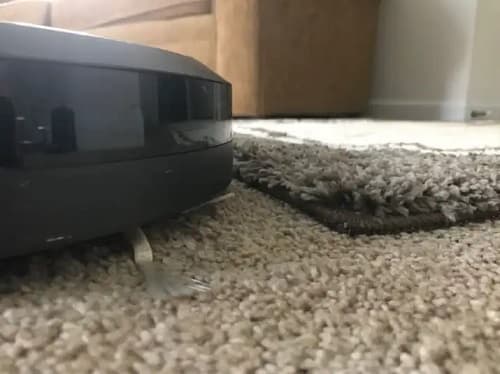
Shaggy rugs and carpets on the floor are other reasons for your Roomba to get stuck into it, but it does not specifically happen to low pile carpets. Robot vacuums can easily go through the low pile carpets.
But, if your living room or bedroom has shaggy or thick pile carpets, it may be a great nuisance for the robot vacuum to work. The reason is that the high pile carpets have a thickness of 1.5 cm or more, while the height of the robot vacuum from the ground is around 1.2 cm only, which makes the robovac stuck on shaggy and thick carpets.
4. Clogged Brush or Wheels
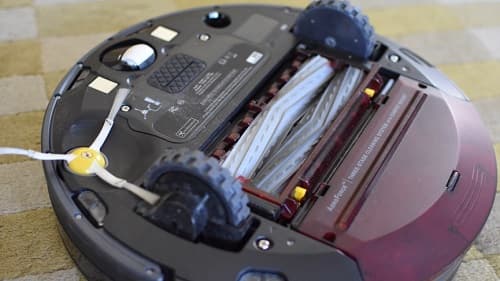
In the course of daily cleaning, dirt, grime, pet hair, and other particles can get stuck in the brushes and wheels of your robot vacuum. It can clog the brush and wheels of the robot vacuum. Clogged brush and wheels may create a great hindrance for your robot vacuum to work. Therefore, cleaning and maintaining your Roomba is necessary to keep it operating properly.
5. Furniture is Too Low
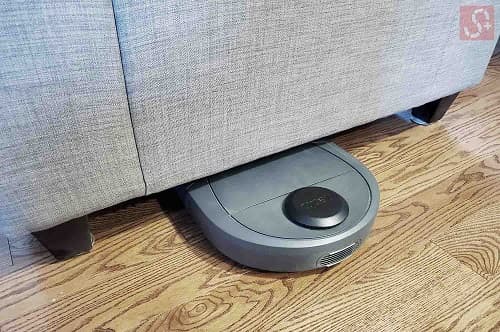
Regular furniture at your home like sofa, couches, bed, chair, desk, etc., has a different height. And If the robot vacuum’s height from the ground is approximately the same as or higher than the furniture’s height from the ground, it is most likely to get stuck under it.
6. Inappropriate Docking Station
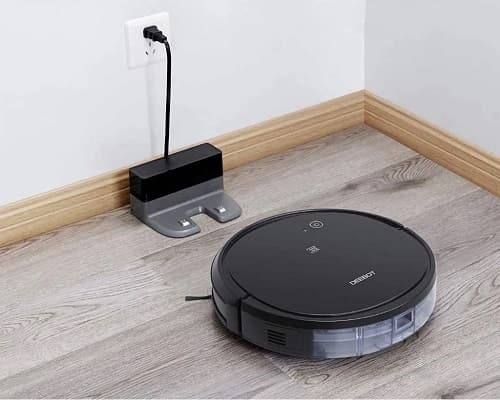
The robot vacuum’s docking station is one of the most important elements of the unit’s cleaning system. A docking station, also referred to as the Homebase of the robot, directs the device and guides it through signals for efficient cleaning around the house. Therefore, it is very much important that the Homebase or docking station should be placed appropriately, best if it is placed at a central location in your house.
An improperly placed docking station may cause the robot to lose its signals and get stuck as a result.
7. Improper Light or Dark Area
The hi-tech robot vacuums are equipped with infrared and optical sensors to avoid obstacles in front of them. If there is insufficient light, the sensors may not recognize obstacles in front of them, resulting in the device bumping into the objects or getting stuck under the furniture.
To ensure these sensors perform appropriately, there must be adequate light in the area where the robot vacuum is working.
8. Dark Furniture and Rugs
Well, this is not a problem with newer models of robot vacuums. The problem mostly affects older models of robotic vacuums. As we have discussed above, the dark conditions will misguide the robot vacuum’s function. So, if there is a dark rug or furniture in the way, the sensor won’t work properly, and the unit is likely to fall over or get stuck.
How to Stop a Robot Vacuum from Getting Stuck?
We have discussed the reasons why the Roomba gets stuck? Now, let’s find out some easy tips and tricks that will let you stop a robot vacuum from getting stuck and make it work appropriately.
1. Clear out Obstacles and Clutters From the Floor Before Turning the Device On
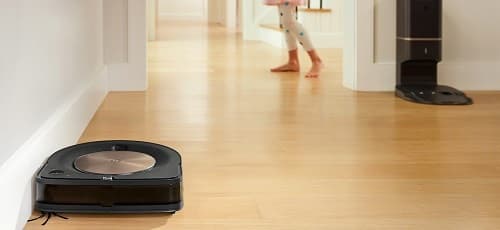
Prior to starting your robot vacuum, you must remove all the mess from your floor so that its path is clear and it can work efficiently. The clutters include any kind of toys, pillows, clothing, or any other objects. Most importantly, pay special attention to removing very tiny objects like pins, coins, etc., as they may cause damage to the internal components of the vacuum.
The furniture in your home is another obstacle creating hindrance while your robot vacuum is working. So, you must prepare the area before turning on your Roomba. Chairs, dining tables, or sofas are the common furniture where the robot gets stuck. Better to place chairs somewhere else while the robot vacuum is cleaning. For dining table chairs, it is best to put them on the dining table upside down before turning the device on for cleaning.
2. Use Furniture Risers
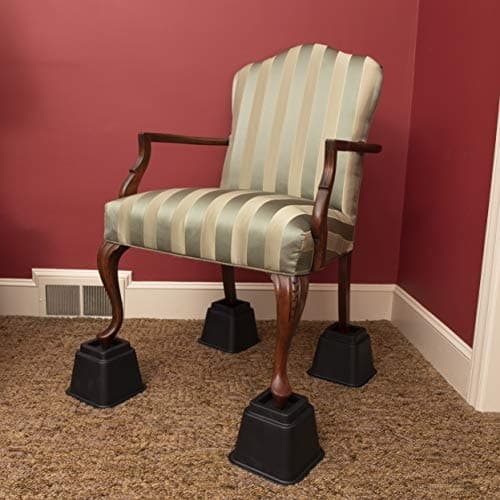
The best way to prevent a robot vacuum from becoming stuck under furniture is to use furniture risers under the legs of the furniture (sofa, couch, table, bed, etc.). This will give your furniture an added height so that the vacuum gets enough clearance to roll under it without getting jammed and cleans that area efficiently.
3. Restrict Access to Furniture
In case if you don’t have furniture risers, you can also restrict the bot’s access to furniture so that it won’t get stuck. Access restriction may be done physically or virtually.
Physically, you can put some physical barrier in front of the furniture so that the robot gets bumped onto it and changes its direction automatically before going under it.
For virtual restriction, you can set no-go zones or virtual wall barriers for the areas via mobile application where you don’t want your robot vacuum to go.
4. Use Bumper Extenders
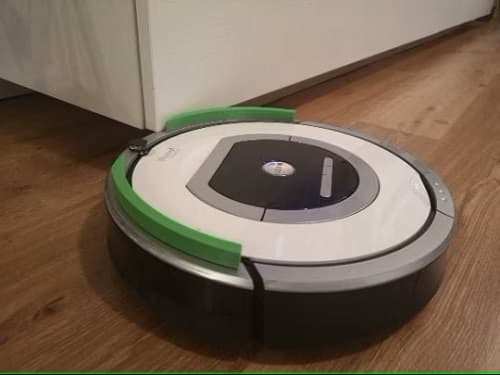
Bumper Extenders are the tiny rubber feet that you can install on the front end of the bumper of the robot vacuum. Once installed, these extenders act as a barrier. So, when your robot vacuum is working, and if it hits any furniture, the bumper tends to change the robot’s cleaning direction and avoid it getting stuck under the furniture.
5. Organize the Cables Lying Around
The next important thing to do before turning on the Roomba is to sort out messy cables and cords from the floor. The best way to do this is either taping the cords to the wall or organizing them neatly as close to the walls. It will prevent the robot vacuum from getting tangled between the cords or cables and getting jammed.
6. Remove Thick Rugs and Carpets or Use Pool Noodles
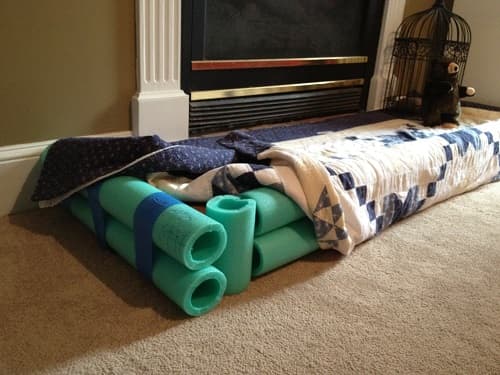
The thick rugs and carpets have stringy fringes or tassels, making the robots inconvenient to run through them and causing them to get stuck. So, it is better to remove those thick area rugs before your device starts operation. If in case the rug is too heavy to remove every time, you can use pool noodles too. Sticking them over all the sides of the carpets will act as a barrier for the robotic vacuum. Therefore, if the unit comes towards it while cleaning and bumps into it, it automatically changes its cleaning direction.
7. Place The Docking Station Optimally
The optimal placement of the docking station for the robot vacuum is very important as it not only charges the vacuum but also guides it for efficient operation.
It is best to place the dock station or Homebase at a central location of your house so that the robot vacuum gets the clearest view of it wherever it is working.
Avoid placing the dock station near stairs, corners, or other closet places.
Make sure the robot has enough room to maneuver and line up with the dock.
8. Keep Lights On to Improve Visibility
As discussed above, robot vacuums have optical sensors for their efficient navigation. These optical sensors use light to detect things, and thus your robot vacuum works best if there are proper lights all around.
The lack of light causes the robot to bump onto the objects or become stuck under them due to invisibility. Therefore, keep lights on during the cleaning session, so the robot sensors work perfectly to clean the area.
9. Clean Your Robot Vacuum After Each Use
The wheel bearings and the brush of the robot vacuum tend to collect dust, pet hair, and debris over time, causing it to jam while working. So, it is very important to spend a few seconds brushing away those dirt, dust, and pet hair from the wheels and spinning brushes of the vacuum after each cleaning season. It will allow a smooth cleaning operation of the robot during your next cleaning cycle.
Read Next: How does a Robot Vacuum Cleaner Navigate Your Home?